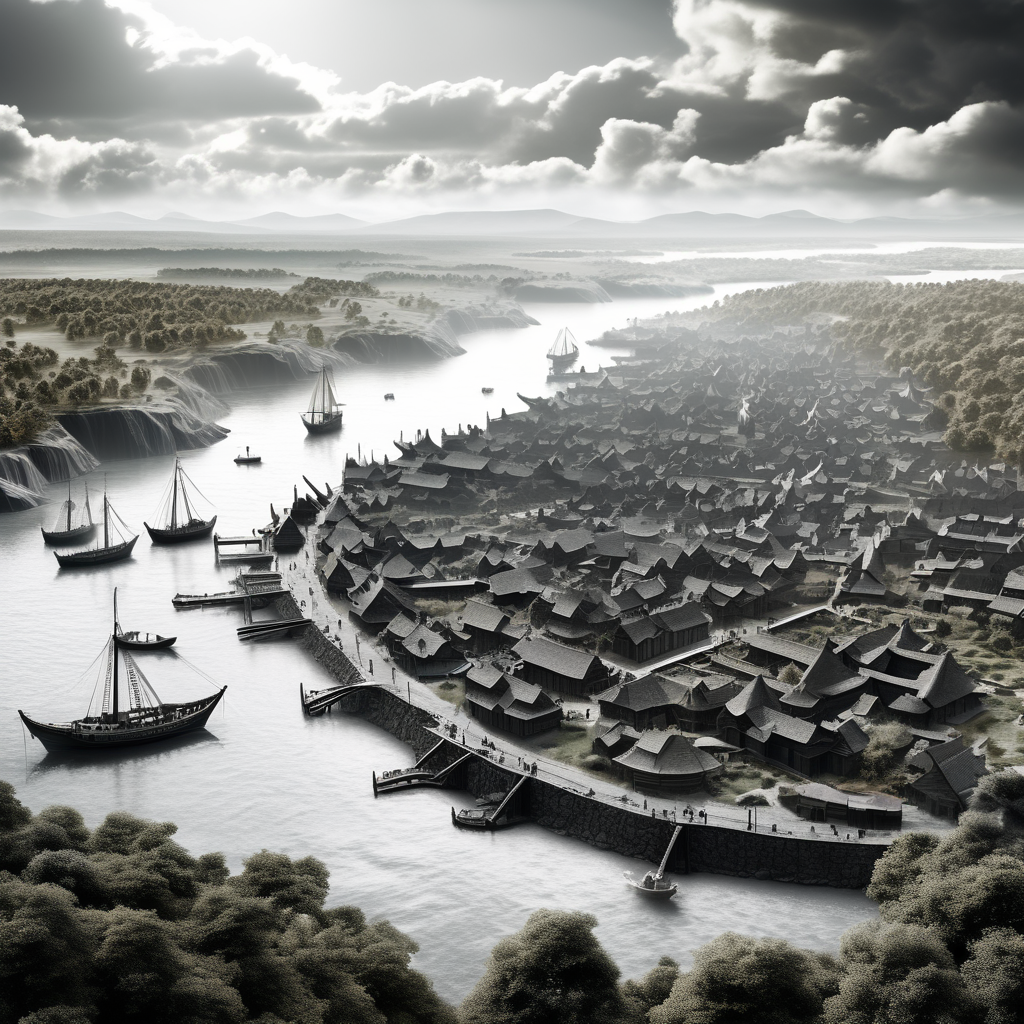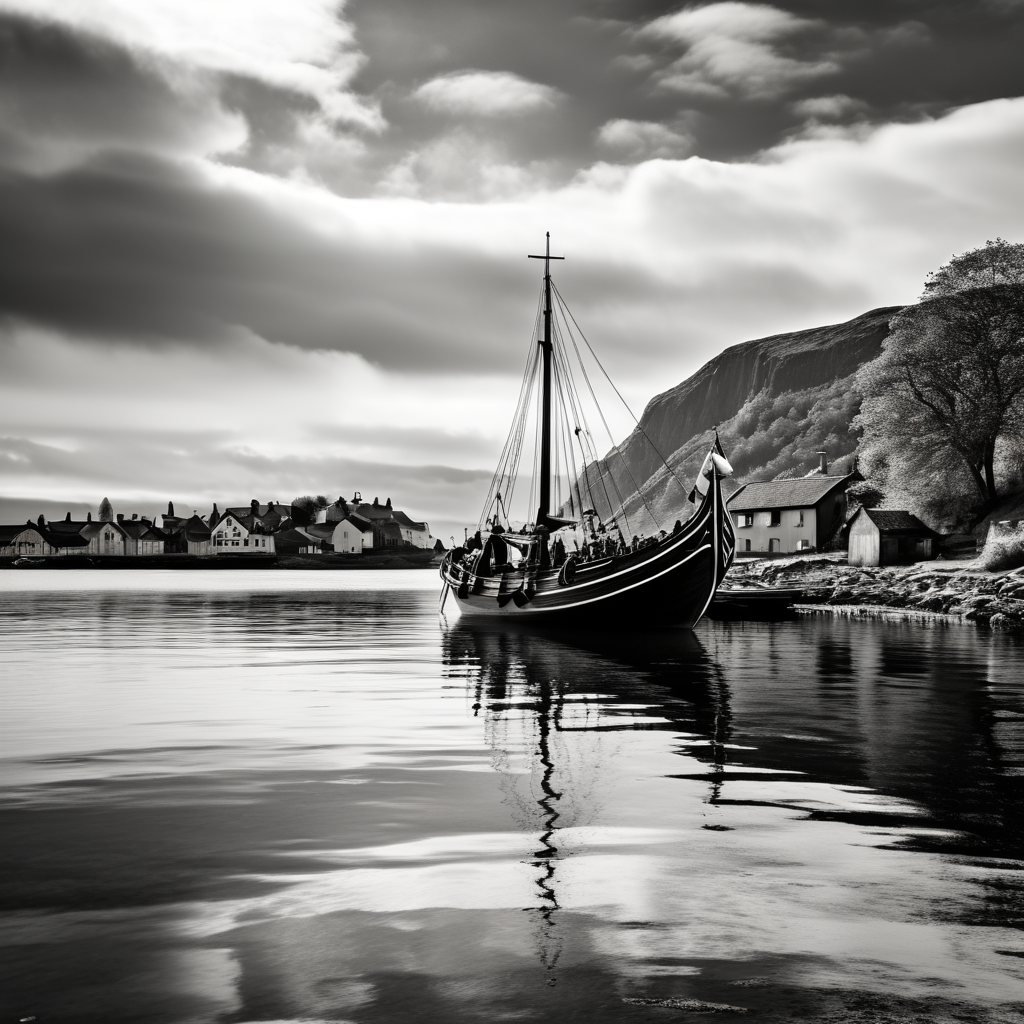
01 Feb Places of new order: Haithabu or the first metropolis of the north
The Viking town of Haithabu was a trading center and melting pot of cultures for centuries before it was destroyed in 1066 and never rebuilt.
“The woman divorces herself when she wants to” and he had never heard anything uglier than the singing of men. This was reported by Ibrahim ibn Yaqub, envoy of the Caliph of Córdoba, in 965/966 from Haithabu, the “city on the farthest edge of the sea”.
For centuries, the trading metropolis of the Danish Vikings was the main hub for long-distance trade between Scandinavia, Western Europe, the North Sea region and the Baltic States. In 1066, the medieval town was devastated by Western Slavs and never rebuilt – its demise also marked the end of the Viking Age. Haithabu, located in the south of the Cimbrian Peninsula at the end of the Schlei, an arm of the Baltic Sea that reaches far inland, had already suffered a severe blow in 1050: King Harald of Norway’s troops had succeeded in reducing the town to rubble, although a nine-metre-high rampart with a palisade should have protected its more than 1,000 inhabitants.
Today, the abandoned site in Schleswig-Holstein is an important archaeological site and a UNESCO World Heritage Site. It was no coincidence that Ibrahim ibn Yaqub made the long journey from Spain to the Baltic Sea. The Jewish scholar also reported to the Caliph from Mainz, Speyer and Worms, from Prague and from Krakow. His travel reports are considered to be among the most important narrative sources of the time.
Haithabu, the “first metropolis of the north”, can be understood as a historical “place of new order”. These “places of new order” are centers and spaces in which significant changes, developments or paradigm shifts take place, both yesterday and today. They are characterized by a combination of creative energy, technological progress, intellectual exchange and often also by a specific socio-economic or political constellation.
In a prime location
“The long economic crisis of late antiquity finally abated in the seventh and eighth centuries. Upswing in sight! But Europe had changed. The focus was no longer on the Mediterranean; money was now being made in the north-east,” writes historian Anne Mann. At that time, trade with England was conducted via the North Sea and the estuaries of the Rhine, Meuse and Scheldt, while business with Scandinavia was conducted via the Baltic Sea. In turn, traders reached Constantinople, today’s Istanbul, via Russian waterways. The Frisians were particularly enterprising and probably founded Haithabu in the eighth century, initially as a temporary trading base for the summer. “The location was well chosen, the bay at the end of the Schlei was sheltered and the water was shallow, so that ships could run onto the beach for loading and unloading. But the best thing was that the North Sea was just 18 kilometers away by land, a distance that was easy to manage with carts. This meant you could avoid the dangerous sea route around modern-day Denmark and reach the North Sea via the Treene and Eider rivers.”
Under the control of the Danish king Godofred, Haithabu, the settlement on the heath, experienced its first heyday at the beginning of the ninth century: the Viking destroyed the rival trading center of Reric in the Bay of Wismar, kidnapped wealthy merchants and settled them in Haithabu. Not least because everyone wanted to do good business, the town prospered. The Danewerk, a system of walls around 30 kilometers long, ten meters wide and five meters high, protects the intersecting trade routes that stretch from the Iberian Peninsula to Mesopotamia and from the White Sea in northern Russia to the Aegean Sea. Haithabu’s location close to the border with Charlemagne’s Frankish Empire led to a trade agreement in 873, which regulated the flourishing cross-border exchange of goods.
The small trading center becomes a town, Haithabu has up to 1000 inhabitants, almost exclusively merchants and craftsmen. They come from Saxony, Friesland and the Franconian Empire, are Slavs and Swedes, or, like Ibrahim ibn Yaqub, envoys from distant Islamic Spain. The city fathers understand that a functioning port is the basis for their prosperity: they lavishly expand the port facilities, invest in landing bridges and create a huge cargo handling area.
Amazon central warehouse of the early Middle Ages
Whether amber and furs, honey and wax, ceramics and weapons or mercury and tin: Haithabu was something like the Amazon central warehouse of the early Middle Ages, which were drawing to a close. Freeze-dried cod was even delivered from the Lofoten Islands, more than 2000 kilometers away, and found its buyers in the port town on the Schlei. However, as so often in history, the most profit was made with the “human commodity”. Anne Mann reports: “Prisoners of war and people who had fallen into the hands of robbers or pirates and could not afford the ransom were offered for sale. The most important buyer was Islamic Spain, but slavery was widespread throughout Europe. Most slaves came from the vast areas of Eastern Europe. The Slavic regions offered an almost inexhaustible reservoir. In addition, the East mainly supplied pagan slaves, which was a great advantage, as Christian slaves were not allowed to fall into the hands of pagans according to church law, i.e. they could not be handed over to Jewish traders and certainly not sold into Islamic territories. In principle, the Church had nothing against the slave trade. It was only strict on two points: no Christians in pagan hands and no sex with slaves. Not that it was always adhered to.”
Even religion was a location factor in Haithabu: King Horik I professed religious freedom and allowed a Christian church to be built in order to attract Christian traders. “Life in Haithabu was a life on the border, with the Scandinavian-pagan world of the Vikings on one side and the Christian world of the Franks on the other. Graves of Scandinavians (especially Danes), Franks, Saxons, North Frisians and Slavs have been found in Haithabu. The transition from cremation burial to inhumation burial took place much earlier than in the surrounding area, and there are significantly fewer grave goods.”
Dump
But Haithabu’s end was not far off: The actual downfall of the town was probably not the attack by the Norwegian Vikings in 1050, nor the looting and pillaging by the West Slavs in 1066 – it was the fact that nobody wanted to rebuild the town. The fact that the inhabitants had used the harbor for centuries as a dumping ground for waste and ballast stones from the ships and that the newer generation of merchant ships had an ever greater draught was to take its toll. Expanding, relocating and renewing the jetties and harbor facilities once again, as they had had to do so many times before, was obviously simply too expensive for the businessmen this time. They gave up on the settlement – and drew the line under the success story of a place of new order.
In retrospect, Haithabu was not only a place of exceptional economic dynamism with favorable political and regulatory conditions and a uniquely favorable topographical location. It was also a cultural melting pot with excellent connections spanning thousands of kilometers, attracting traders and craftsmen from all over Europe. The import of exclusive trade goods led to the development of highly specialized trades – like start-ups of earlier days: elaborate goldsmithing and pressed sheet metal work, the art of woodturning and the manufacture of weapons are considered historically proven. Haithabu’s cultural diversity is reflected not least in its precious everyday objects, jewelry and burial culture.
The latter is impressively documented by one of the most magnificent graves of the Viking Age: near Haithabu, there is a mound with an 18-metre-long, seaworthy warship buried inside. Under the keel, three men found their final resting place in a wooden chamber, equipped with Frankish swords, shields, arrows, bridles – and the horses that went with them.



